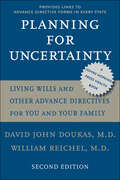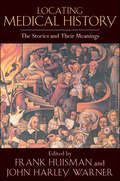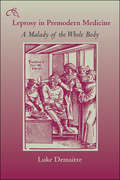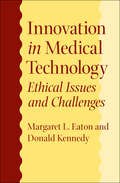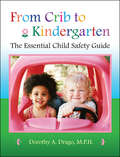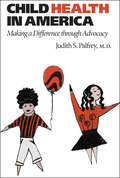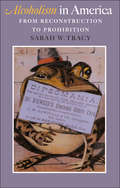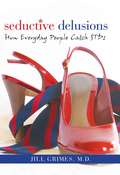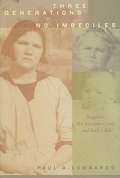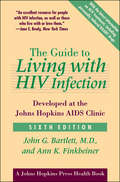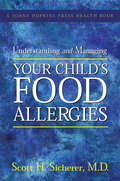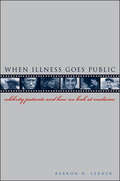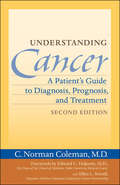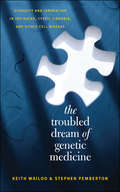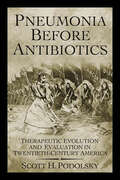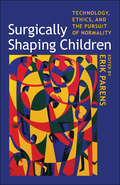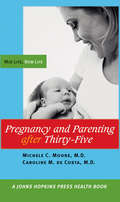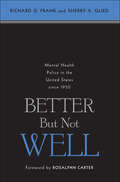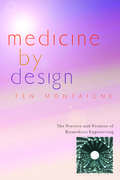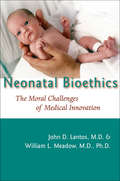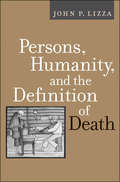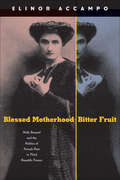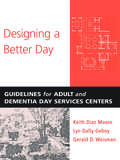- Table View
- List View
Planning for Uncertainty: Living Wills and Other Advance Directives for You and Your Family (A Johns Hopkins Press Health Book)
by William Reichel David John DoukasIt won’t happen to me.I’m too busy to worry about a living will.My family will know what to do.No one wants to plan for death or incapacitating illness. But, as the emotional legal battle in the Terri Schiavo case made all too clear, people of all ages need to document and communicate clear decisions about the final details of their lives while they are healthy and have time to fully consider their own values and preferences.Here, Drs. David Doukas and William Reichel help individuals make decisions and communicate their wishes to health care providers and family members and other loved ones.Drs. Doukas and Reichel use a question-and-answer format to guide readers through the process—emphasizing the crucial connection between values and treatment preferences. They explain advance directives and the health care decision-making process, including the values history, family covenants, proxies, and proxy negation. The appendix includes resources and Web links for learning about advance directive requirements and obtaining legal forms in all fifty states.This practical guide helps people navigate the important but often intimidating process of thinking about, and planning for, an uncertain future.
Planning For Uncertainty: Living Wills and Other Advance Directives for You and Your Family (A Johns Hopkins Press Health Book)
by William Reichel David John DoukasA practical guide to documenting your decisions and preferences in case of incapacitating illness.It won’t happen to me.I’m too busy to worry about a living will.My family will know what to do.No one wants to plan for incapacitating illness or death. But to spare loved ones from needless emotional suffering, or even legal battles, people of all ages need to document and communicate clear decisions about the final details of their lives while they are healthy and have time to fully consider their own values and preferences.Here, Drs. David Doukas and William Reichel help individuals make decisions and communicate their wishes to health care providers and family members and other loved ones. They use a question-and-answer format to guide readers through the process—emphasizing the crucial connection between values and treatment preferences. They explain advance directives and the health care decision-making process, including the values history, family covenants, proxies, and proxy negation. The appendix includes resources and web links for learning about advance directive requirements and obtaining legal forms in all fifty states.This practical guide helps people navigate the intimidating but important process of thinking about, and planning for, an uncertain future.
Locating Medical History: The Stories and Their Meanings
by Frank Huisman and John Harley WarnerThe issues constituting the history of medicine are consequential: how societies organize health care, how individuals or states relate to sickness, how we understand our own identity and agency as sufferers or healers. In Locating Medical History: The Stories and Their Meanings, Frank Huisman, John Harley Warner, and other eminent historians explore and reflect on a field that accommodates a remarkable diversity of practitioners and approaches.At a time when medical history is facing profound choices about its future, these scholars explore the discipline in the distant and recent past in order to rethink its missions and methods today. They discuss such issues as the periodic estrangement of medical history from medicine, the influence of Foucault on the writing of medical history, and the shifts from social to cultural history and back again. Chapters explore the early history of the field, its transformations since the 1970s, and its prospects for the future.With diverse constituencies, a multiplicity of approaches, styles, and aims is both expected and desired. This volume locates medical history within itself and within larger historiographic trends, to provide a springboard for discussions about what the history of medicine should be, and what aims it should serve.Contributors: Olga Amsterdamska, University of Amsterdam; Warwick Anderson, University of Wisconsin, Madison; Allan M. Brandt, Harvard Medical School; Theodore M. Brown, University of Rochester; Roger Cooter, University College London; Martin Dinges, Institut für Geschichte der Medizin der Robert Bosch Stiftung; Alice Domurat Dreger, Michigan State University; Jacalyn Duffin, Queen's University; Elizabeth Fee, National Library of Medicine; Mary E. Fissell, The Johns Hopkins University; Danielle Gourevitch, École Pratique des Hautes Études; Anja Hiddinga, University of Amsterdam; Ludmilla Jordanova, University of East Anglia; Alfons Labisch, Heinrich-Heine-University; Hans-Uwe Lammel, University of Rostock; Sherwin B. Nuland, Yale University; Vivian Nutton, University College London; Roy Porter, formerly University College London; Susan M. Reverby. Wellesley College; David Rosner, Columbia University; Thomas Rütten, University of Newcastle upon Tyne; Heinz-Peter Schmiedebach, University of Greifswald; Christiane Sinding, Institut National de la Santé et de la Recherche Médicale
Leprosy in Premodern Medicine: A Malady of the Whole Body
by Luke DemaitreWhile premodern poets and preachers viewed leprosy as a "disease of the soul," physicians in the period understood it to be a "cancer of the whole body." In this innovative study, medical historian Luke Demaitre explores medical and social perspectives on leprosy at a time when judicious diagnosis could spare healthy people from social ostracization and help the afflicted get a license to beg.Extending his inquiry from the first century to late in the eighteenth century, Demaitre draws on translations of academic treatises and archival records to illuminate the professional standing, knowledge, and conduct of the practitioners who struggled to move popular perceptions of leprosy beyond loathing and pity. He finds that, while not immune to social and cultural perceptions of the leprous as degenerate, and while influenced by their own fears of contagion, premodern physicians moderated society's reactions to leprosy and were dedicated to the well-being of their patients.
Innovation in Medical Technology: Ethical Issues and Challenges
by Donald Kennedy Margaret L. EatonThis thought-provoking study examines the ethical, legal, and social problems that arise with cutting-edge medical technology. Using as examples four powerful and largely unregulated technologies—off-label use of drugs, innovative surgery, assisted reproduction, and neuroimaging—Margaret L. Eaton and Donald Kennedy illustrate the difficult challenges faced by clinicians, researchers, and policy makers who seek to advance the frontiers of medicine safely and responsibly.Supported by medical history and case studies and drawing on reports from dozens of experts, the authors address important practical, ethical, and policy issues. They consider topics such as the responsible introduction of new medical products and services, the importance of patient consent, the extent of the duty to mitigate harm, and the responsibility to facilitate access to new medical therapies.This work's insights into the nature and consequences of medical innovation contribute to the national debate on how best to protect patients while fostering innovation and securing benefits.
From Crib to Kindergarten: The Essential Child Safety Guide
by Dorothy A. DragoNamed One of the Best Consumer Health Books of 2007 by Library JournalIn childhood, the occasional bump or scrape comes with the territory. But serious injury is another matter, creating anxiety for even the most experienced parent. Fortunately, unintentional injury can be prevented. In this essential guide, an eminent child safety specialist explains how to reduce the risk of childhood injury at home—and beyond. Her tips help protect children from birth to age five—those who are most vulnerable to serious injury. She describes how to provide a safe environment during the daily activities of sleeping, eating, bathing, dressing, playing, and traveling. The major hazards and potential injuries associated with each activity are identified along with the age when the child is at greatest risk. Illustrations, checklists, and summary charts complement the text and put valuable lessons and critical information at parents’ fingertips.From Crib to Kindergarten is an indispensable "how to" for parents, grandparents, teachers, babysitters, and daycare providers.
Child Health in America: Making a Difference through Advocacy
by Judith S. PalfreyWho will speak for the children? is the question posed by Judith S. Palfrey, a pediatrician and child advocate who confronts unconscionable disparities in U.S. health care—a system that persistently fails sick and disabled children despite annual expenditures of $1.8 trillion.In Child Health in America, Palfrey explores the meaning of advocacy to children's health and describes how health providers, community agencies, teachers, parents, and others can work together to bring about needed change. Palfrey presents a conceptual framework for child health advocacy consisting of four interconnected components: clinical, group, professional, and legislative. Describing each of these concepts in useful and compelling detail, she is also careful to provide examples of best practices.This original and progressive work affirms the urgent need for child advocacy and provides valuable guidance to those seeking to participate in efforts to help all children live healthier, happier lives.
Alcoholism in America: From Reconstruction to Prohibition
by Sarah W. TracyDespite the lack of medical consensus regarding alcoholism as a disease, many people readily accept the concept of addiction as a clinical as well as a social disorder. An alcoholic is a victim of social circumstance and genetic destiny. Although one might imagine that this dual approach is a reflection of today's enlightened and sympathetic society, historian Sarah Tracy discovers that efforts to medicalize alcoholism are anything but new.Alcoholism in America tells the story of physicians, politicians, court officials, and families struggling to address the danger of excessive alcohol consumption at the turn of the century. Beginning with the formation of the American Association for the Cure of Inebriates in 1870 and concluding with the enactment of Prohibition in 1920, this study examines the effect of the disease concept on individual drinkers and their families and friends, as well as the ongoing battle between policymakers and the professional medical community for jurisdiction over alcohol problems. Tracy captures the complexity of the political, professional, and social negotiations that have characterized the alcoholism field both yesterday and today.Tracy weaves American medical history, social history, and the sociology of knowledge into a narrative that probes the connections among reform movements, social welfare policy, the specialization of medicine, and the social construction of disease. Her insights will engage all those interested in America's historic and current battles with addiction.
Seductive Delusions: How Everyday People Catch STDs
by Jill GrimesWriting to help general readers become more aware of the risks associated with sexual activity, Grimes, a family physician and faculty member at the U. of Massachusetts Medical School, recounts the stories of young people from all walks of life infected with sexually transmitted diseases: herpes, human papilloma virus and resulting cervical cancer, chlamydia, gonorrhea, trichomoniasis, pubic lice, HIV, hepatitis C, and syphilis. Each section includes facts on symptoms, diagnosis, treatment, prevention, and other information about the STD. She does not include information about pregnancy or stories about homosexual partners. Annotation ©2009 Book News, Inc., Portland, OR (booknews.com)
Three Generations, No Imbeciles: Eugenics, the Supreme Court, and Buck v. Bell
by Paul A. Lombardo"Three generations of imbeciles are enough." Few lines from Supreme Court opinions are as memorable as this declaration by Justice Oliver Wendell Holmes Jr. in the landmark 1927 case Buck v. Bell. The ruling allowed states to forcibly sterilize residents in order to prevent "feebleminded and socially inadequate" people from having children. It is the only time the Supreme Court endorsed surgery as a tool of government policy. Paul Lombardo's startling narrative exposes the Buck case's fraudulent roots. In 1924 Carrie Buck -- involuntarily institutionalized by the State of Virginia after she was raped and impregnated -- challenged the state's plan to sterilize her. Having already judged her mother and daughter mentally deficient, Virginia wanted to make Buck the first person sterilized under a new law designed to prevent hereditarily "defective" people from reproducing. Lombardo's more than twenty-five years of research and his own interview with Buck before she died demonstrate conclusively that she was destined to lose the case before it had even begun. Neither Carrie Buck nor her mother and daughter were the "imbeciles" condemned in the Holmes opinion. Her lawyer -- a founder of the institution where she was held -- never challenged Virginia's arguments and called no witnesses on Buck's behalf. And judges who heard her case, from state courts up to the U.S. Supreme Court, sympathized with the eugenics movement. Virginia had Carrie Buck sterilized shortly after the 1927 decision. Though Buck set the stage for more than sixty thousand involuntary sterilizations in the United States and was cited at the Nuremberg trials in defense of Nazi sterilization experiments, it has never been overturned. Three Generations, No Imbeciles tracks the notorious case through its history, revealing that it remains a potent symbol of government control of reproduction and a troubling precedent for the human genome era.
The Guide to Living with HIV Infection: Developed at the Johns Hopkins AIDS Clinic (A Johns Hopkins Press Health Book)
by Ann K. Finkbeiner John G. BartlettThe Guide to Living with HIV Infection is the most complete source of medical, emotional, social, and practical advice available for those infected with HIV and their loved ones. Developed at the Johns Hopkins AIDS Clinic, the guide provides essential information for making decisions about treatment and testing in a world transformed by new research and pharmacotherapy.In this thoroughly updated sixth edition, Dr. John Bartlett and Ann K. Finkbeiner address the latest information about risks of transmission, viral mutations that confer drug resistance, and new, rapid, HIV testing. They offer guidelines for Highly Active Antiretroviral Therapy (HAART), a therapy protocol that has dramatically increased life expectancy for HIV-positive people. They describe how to follow HAART and when to change drug regimens, the symptoms of and treatments for HAART side effects, and the costs of and insurance coverage for HAART. They also outline the possibilities for a diagnosis of "no detectable virus."Accompanied by updated references and resources, the sixth edition of The Guide to Living with HIV Infection offers new hope for people living with a virus that once left no hope at all.
Understanding and Managing Your Child's Food Allergies (A Johns Hopkins Press Health Book)
by Scott H. SichererFor children with food allergies, eating—one of the basic functions of life—can be a nightmare. Children who suffer or become dangerously ill after eating peanuts, seafood, milk, eggs, wheat, or a host of other foods require constant vigilance from caring, concerned parents, teachers, and friends.In this empathetic and comprehensive guide, Dr. Scott H. Sicherer, a specialist in pediatric food allergies, gives parents the information they need to manage their children’s health and quality of life. He describes why children develop food allergy, the symptoms of food allergy (affecting the skin, the gastrointestinal tract, and the respiratory system), and the role of food allergy in behavioral problems and developmental disabilities. Parents will learn how to recognize emergency situations, how to get the most out of a visit with an allergist, what allergy test results mean, and how to protect their children—at home, at school, at summer camp, and in restaurants.Informative, compassionate, and practical, this guide will be indispensable for parents, physicians, school nurses, teachers, and everyone else who cares for children with food allergies.
When Illness Goes Public: Celebrity Patients and How We Look at Medicine
by Barron H. LernerOutstanding Academic Title, 2007, Choice magazineSteve McQueen had cancer and was keeping it secret. Then the media found out, and soon all of America knew. McQueen’s high profile changed forever the way the public perceived a dreaded disease. In When Illness Goes Public, Barron H. Lerner describes the evolution of celebrities' illnesses from private matters to stories of great public interest. Famous people who have become symbols of illness include Lou Gehrig, the first "celebrity patient"; Rita Hayworth, whose Alzheimer disease went undiagnosed for years; and Arthur Ashe, who courageously went public with his AIDS diagnosis before the media could reveal his secret. And then there are private citizens like Barney Clark, the first recipient of a permanent artificial heart, and Lorenzo Odone, whose neurological disorder became the subject of a Hollywood film. While celebrity illnesses have helped to inform patients about treatment options, ethical controversies, and scientific proof, the stories surrounding these illnesses have also assumed mythical characteristics that may be misleading. Marrying great storytelling to an exploration of the intersection of science, journalism, fame, and legend, this book is a groundbreaking contribution to our understanding of health and illness.
Understanding Cancer: A Patient's Guide to Diagnosis, Prognosis, and Treatment
by C. Norman ColemanThe greatest need of anyone with cancer is to understand the disease—its diagnosis, treatment options, and the often devastating experience of having cancer. In Understanding Cancer, Dr. C. Norman Coleman explains how to gather information about treatments and how to interpret that information to make decisions. He helps the person with cancer prepare for visits to doctors and the hospital and to make those visits as productive as possible. He distills the often complex medical terms and concepts underlying the statistics and percentages used to characterize medical conditions. With clear, in-depth discussions of pretreatment staging of disease, the biology of cancer, how successful treatment is defined, and how best to manage one's time, Understanding Cancer helps people with cancer and their families become active participants in the decision-making process.In the second edition of this highly respected guide, Dr. Coleman describes new treatments that target specific types of cancer as well as treatments that are designed for a particular individual. He discusses the era of molecular medicine, including biomarkers, novel imaging, molecular signatures and profiling, and molecular-targeted therapy. Many of these therapies are currently only available through a clinical trial, so Dr. Coleman includes a detailed discussion of what is involved in participating in research trials.Compassionate, accessible, and informative, Understanding Cancer will increase the reader's knowledge of medical concepts and terms so the person with cancer, the family, and the health care team can work together efficiently—and effectively.
The Troubled Dream of Genetic Medicine: Ethnicity and Innovation in Tay-Sachs, Cystic Fibrosis, and Sickle Cell Disease
by Keith Wailoo Stephen PembertonWinner of the History of Science category of the Professional and Scholarly Publishing Awards given by the Association of American PublishersWhy do racial and ethnic controversies become attached, as they often do, to discussions of modern genetics? How do theories about genetic difference become entangled with political debates about cultural and group differences in America? Such issues are a conspicuous part of the histories of three hereditary diseases: Tay-Sachs, commonly identified with Jewish Americans; cystic fibrosis, often labeled a "Caucasian" disease; and sickle cell disease, widely associated with African Americans. In this captivating account, historians Keith Wailoo and Stephen Pemberton reveal how these diseases—fraught with ethnic and racial meanings for many Americans—became objects of biological fascination and crucibles of social debate. Peering behind the headlines of breakthrough treatments and coming cures, they tell a complex story: about different kinds of suffering and faith, about unequal access to the promises and perils of modern medicine, and about how Americans consume innovation and how they come to believe in, or resist, the notion of imminent medical breakthroughs. With Tay-Sachs, cystic fibrosis, and sickle cell disease as a powerful backdrop, the authors provide a glimpse into a diverse America where racial ideologies, cultural politics, and conflicting beliefs about the power of genetics shape disparate health care expectations and experiences.
Pneumonia Before Antibiotics: Therapeutic Evolution and Evaluation in Twentieth-Century America
by Scott H. PodolskyPneumonia—Osler's "Captain of the Men of Death" and still the leading infectious cause of death in the United States—has until now received scant attention from historians. In Pneumonia Before Antibiotics, clinician-historian Scott H. Podolsky uses pneumonia's enduring prevalence and its centrality to the medical profession's therapeutic self-identity to examine the evolution of therapeutics in twentieth-century America. Focusing largely on the treatment of pneumonia in first half of the century with type-specific serotherapy, Podolsky provides insight into the rise and clinical evaluation of therapeutic "specifics," the contested domains of private practice and public health, and-as the treatment of pneumonia made the transition from serotherapy to chemotherapy and antibiotics—the tempo and mode of therapeutic change itself. Type-specific serotherapy, founded on the tenets of applied immunology, justified by controlled clinical trials, and grounded in a novel public ethos, was deemed revolutionary when it emerged to replace supportive therapeutics. With the advent of the even more revolutionary sulfa drugs and antibiotics, pneumonia ceased to be a public health concern and became instead an illness treated in individual patients by individual physicians. Podolsky describes the new therapeutics and the scientists and practitioners who developed and debated them. He finds that, rather than representing a barren era in anticipation of some unknown transformation to come, the first decades of the twentieth-century shaped the use of, and reliance upon, the therapeutic specific throughout the century and beyond. This intriguing study will interest historians of medicine and science, policymakers, and clinicians alike.
Pneumonia Before Antibiotics: Therapeutic Evolution and Evaluation in Twentieth-Century America
by Scott H. Podolsky“Uses [pneumonia] as a vehicle for examining the evolution of therapeutics in America between the ‘Golden Age of Microbiology’ and the ‘Age of Antibiotics.’”—IsisFocusing largely on the treatment of pneumonia in first half of the century with type-specific serotherapy, clinician-historian Scott H. Podolsky provides insight into the rise and clinical evaluation of therapeutic “specifics,” the contested domains of private practice and public health, and—as the treatment of pneumonia made the transition from serotherapy to chemotherapy and antibiotics—the tempo and mode of therapeutic change itself. Type-specific serotherapy, founded on the tenets of applied immunology, justified by controlled clinical trials, and grounded in a novel public ethos, was deemed revolutionary when it emerged to replace supportive therapeutics. With the advent of the even more revolutionary sulfa drugs and antibiotics, pneumonia ceased to be a public health concern and became instead an illness treated in individual patients by individual physicians.Podolsky describes the new therapeutics and the scientists and practitioners who developed and debated them. He finds that, rather than representing a barren era in anticipation of some unknown transformation to come, the first decades of the twentieth-century shaped the use of, and reliance upon, the therapeutic specific throughout the century and beyond. This intriguing study will interest historians of medicine and science, policymakers, and clinicians alike.“Podolsky’s scholarship is awesome, and his grasp of the philosophical and sociologic context of the issues considered make this an important work.” —New England Journal of Medicine“This thoroughly documented, carefully written book is a landmark analysis . . . It should be read by everyone who is involved in research and therapeutic development.” —JAMA
Surgically Shaping Children: Technology, Ethics, and the Pursuit of Normality
by Erik ParsensWinner of an Honorable Mention in the Clinical Medicine category of the Professional and Scholarly Publishing Awards given by the Association of American PublishersAt a time when medical technologies make it ever easier to enhance our minds and bodies, a debate has arisen about whether such efforts promote a process of "normalization," which makes it ever harder to tolerate the natural anatomical differences among us. The debate becomes especially complicated when it addresses the surgical alteration, or "shaping," of children. This volume explores the ethical and social issues raised by the recent proliferation of surgeries designed to make children born with physical differences look more normal.Using three cases—surgeries to eliminate craniofacial abnormalities such as cleft lip and palate, surgeries to correct ambiguous genitalia, and surgeries to lengthen the limbs of children born with dwarfism—the contributors consider the tensions parents experience when making such life-altering decisions on behalf of or with their children.The essays in this volume offer in-depth examinations of the significance and limits of surgical alteration through personal narratives, theoretical reflections, and concrete suggestions about how to improve the decision-making process. Written from the perspectives of affected children and their parents, health care providers, and leading scholars in philosophy, sociology, history, law, and medicine, this collection provides an integrated and comprehensive foundation from which to consider a complex and controversial issue. It takes the reader on a journey from reflections on the particulars of current medical practices to reflections on one of the deepest and most complex of human desires: the desire for normality.ContributorsPriscilla Alderson, Adrienne Asch, Cassandra Aspinall, Alice Domurat Dreger, James C. Edwards, Todd C. Edwards, Ellen K. Feder, Arthur W. Frank, Lisa Abelow Hedley, Eva Fedder Kittay, Hilde Lindemann, Jeffery L. Marsh, Paul Steven Miller, Sherri G. Morris, Wendy E. Mouradian, Donald L. Patrick, Nichola Rumsey, Emily Sullivan Sanford, Tari D. Topolski
Pregnancy and Parenting after Thirty-Five: Mid Life, New Life (A Johns Hopkins Press Health Book)
by Michele C. Moore Caroline M. de CostaMore and more women are having babies after the age of thirty-five and experiencing the joy of motherhood. But mothers-to-be in this age group sometimes face unique medical, emotional, and social challenges. Conception may be difficult and the risk of miscarriage during early pregnancy is higher, as is the potential for complications such as hypertension and diabetes. And having a child later in life can also be surprisingly disruptive to well-established domestic routines and carefully cultivated careers. Michele Moore and Caroline de Costa—two physicians who have been down this road themselves—offer reliable medical expertise and personal reassurance to women tackling these challenges. Pregnancy and Parenting after Thirty-Five covers a broad range of issues for mothers in mid life, from the possibility of Cesarean section to the awkwardness of being the oldest mom at PTA meetings to the joy of holding your infant in your arms. Incorporating the stories of real women who have gone through mid-life pregnancy, Moore and de Costa have created a valuable resource that will help other women do so realistically and with confidence. One of the few books devoted to prospective mothers over thirty-five, this one also includes information on surrogacy, adoption, and the first few months of being a new mother.
Better But Not Well: Mental Health Policy in the United States since 1950
by Richard G. Frank Sherry A. GliedThe past half-century has been marked by major changes in the treatment of mental illness: important advances in understanding mental illnesses, increases in spending on mental health care and support of people with mental illnesses, and the availability of new medications that are easier for the patient to tolerate. Although these changes have made things better for those who have mental illness, they are not quite enough. In Better But Not Well, Richard G. Frank and Sherry A. Glied examine the well-being of people with mental illness in the United States over the past fifty years, addressing issues such as economics, treatment, standards of living, rights, and stigma. Marshaling a range of new empirical evidence, they first argue that people with mental illness—severe and persistent disorders as well as less serious mental health conditions—are faring better today than in the past. Improvements have come about for unheralded and unexpected reasons. Rather than being a result of more effective mental health treatments, progress has come from the growth of private health insurance and of mainstream social programs—such as Medicaid, Supplemental Security Income, housing vouchers, and food stamps—and the development of new treatments that are easier for patients to tolerate and for physicians to manage. The authors remind us that, despite the progress that has been made, this disadvantaged group remains worse off than most others in society. The "mainstreaming" of persons with mental illness has left a policy void, where governmental institutions responsible for meeting the needs of mental health patients lack resources and programmatic authority. To fill this void, Frank and Glied suggest that institutional resources be applied systematically and routinely to examine and address how federal and state programs affect the well-being of people with mental illness.
Medicine by Design: The Practice and Promise of Biomedical Engineering
by Fen MontaigneA heart that once beat erratically has regained its natural rhythm. A woman paralyzed by an automobile accident is now able to resume her favorite hobby. Physicians using a robotic surgeon named da Vinci perform lifesaving operations. These are some of the feats of biomedical engineering, one of the fastest-moving areas in medicine. In this exhilarating book, award-winning writer Fen Montaigne journeys through this little-known world, sharing the stories of ordinary people who have been transformed by technology. From the almost commonplace pacemaker to the latest generation of artificial hearts, Montaigne tells the stories of pioneering patients, engineers, and surgeons. Taking the reader behind the scenes of a dozen of America's leading centers of biomedical engineering, Montaigne recounts the field's history while describing cutting-edge work in medical imaging, orthopedics, cardiovascular care, neurological therapies, and genetics. Through the stories of patients whose lives have been saved and improved by biomedical devices, Montaigne reveals the marriage of medicine and engineering to be one of society's greatest advances.
Neonatal Bioethics: The Moral Challenges of Medical Innovation (Bioethics)
by John D. Lantos William L. MeadowNeonatal intensive care has been one of the most morally controversial areas of medicine during the past thirty years. This study examines the interconnected development of four key aspects of neonatal intensive care: medical advances, ethical analysis, legal scrutiny, and econometric evaluation.The authors assert that a dramatic shift in societal attitudes toward newborns and their medical care was a stimulus for and then a result of developments in the medical care of newborns. They divide their analysis into three eras of neonatal intensive care. The first, characterized by the rapid advance of medical technology from the late 1960s to the Baby Doe case of 1982, established neonatal care as a legitimate specialty of medical care, separate from the rest of pediatrics and medicine. During this era, legal scholars and moral philosophers debated the relative importance of parental autonomy, clinical prognosis, and children's rights. The second era, beginning with the Baby Doe case (a legal battle that spurred legislation mandating that infants with debilitating birth defects be treated unless the attending physician deems efforts to prolong life "futile"), stimulated efforts to establish a consistent federal standard on neonatal care decisions and raised important moral questions concerning the meaning of "futility" and of "inhumane" treatment. In the third era, a consistent set of decision-making criteria and policies was established. These policies were the result of the synergy and harmonization of newly agreed upon ethical principles and newly discovered epidemiological characteristics of neonatal care.Tracing the field's recent history, notable advances, and considerable challenges yet to be faced, the authors present neonatal bioethics as a paradigm of complex conversation among physicians, philosophers, policy makers, judges, and legislators which has led to responsible societal oversight of a controversial medical innovation.
Persons, Humanity, and the Definition of Death (Bioethics)
by John P. LizzaIn this riveting and timely work, John P. Lizza presents the first comprehensive analysis of personhood and humanity in the context of defining death. Rejecting the common assumption that human or personal death is simply a biological phenomenon for biologists or physicians to define, Lizza argues that the definition of death is also a matter for metaphysical reflection, moral choice, and cultural acceptance. Lizza maintains that defining death remains problematic because basic ontological, ethical, and cultural issues have never been adequately addressed. Advances in life-sustaining technology and organ transplantation have led to revision of the legal definition of death. It is generally accepted that death occurs when all functions of the brain have ceased. However, legal and clinical cases involving postmortem pregnancy, individuals in permanent vegetative state, those with anencephaly, and those with severe dementia challenge the neurological criteria. Is "brain death" really death? Should the neurological criteria be expanded to include individuals in permanent vegetative state, with anencephaly, and those with severe dementia? What metaphysical, ethical, and cultural considerations are relevant to answering such questions?Although Lizza accepts a pluralistic approach to the legal definition of death, he proposes a nonreductive, substantive view in which persons are understood as "constituted by" human organisms. This view, he argues, provides the best account of human nature as biological, moral, and cultural and supports a consciousness-related formulation of death. Through an analysis of legal and clinical cases and a discussion of alternative concepts of personhood, Lizza casts greater light on the underlying themes of a complex debate.
Blessed Motherhood, Bitter Fruit: Nelly Roussel and the Politics of Female Pain in Third Republic France
by Elinor AccampoNelly Roussel (1878–1922)—the first feminist spokeswoman for birth control in Europe—challenged both the men of early twentieth-century France, who sought to preserve the status quo, and the women who aimed to change it. She delivered her messages through public lectures, journalism, and theater, dazzling audiences with her beauty, intelligence, and disarming wit. She did so within the context of a national depopulation crisis caused by the confluence of low birth rates, the rise of international tensions, and the tragedy of the First World War. While her support spread across social classes, strong political resistance to her message revealed deeply conservative precepts about gender which were grounded in French identity itself. In this thoughtful and provocative study, Elinor Accampo follows Roussel's life from her youth, marriage, speaking career, motherhood, and political activism to her decline and death from tuberculosis in the years following World War I. She tells the story of a woman whose life and work spanned a historical moment when womanhood was being redefined by the acceptance of a woman's sexuality as distinct from her biological, reproductive role—a development that is still causing controversy today.
Designing a Better Day: Guidelines for Adult and Dementia Day Services Centers
by Keith Diaz Moore Lyn Dally Geboy Gerald D. WeismanWinner of the 2007 Polsky Prize given by the ASID FoundationAs the U.S. population ages, adult day services have become an integral component in the continuum of care for elderly people. Providing a variety of social and medical services for cognitively or physically impaired elderly people who otherwise might reside in institutions, these facilities can be found in a variety of building types, from purpose-built facilities to the proverbial church basement. They also vary widely in their philosophies, case mix, funding mechanisms, and services. In this interdisciplinary study, Keith Diaz Moore, Lyn Dally Geboy, and Gerald D. Weisman offer guidance for planning and designing good-quality adult day services centers. They encourage architects, caregivers, and staff members to think beyond the building, organizational mission, and staffing structure to conceive of the place that emerges as an interrelated system of people, programming, and physical setting. Through case studies, thoughtful explanations, and well-crafted illustrations, Designing a Better Day provides caregivers, architects, and administrators tools with which they can make qualitative changes for participants and their families. Organized into three parts—creating awareness, increasing understanding, and taking action—this book will be a key resource for professionals involved in creating and maintaining effective adult day services centers.
